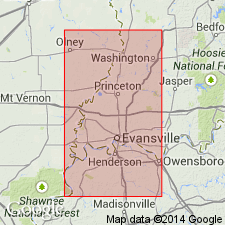
- Usage in publication:
-
- Grayville formation
- Modifications:
-
- First used
- Dominant lithology:
-
- Limestone
- AAPG geologic province:
-
- Illinois basin
Summary:
Grayville formation described as gray fossiliferous limestone in McLeansboro formation. Underlies Lawrenceville shale (new); separated from underlying Mumford Hills sandstone (new) by Aldrich coal.
Source: GNU records (USGS DDS-6; Reston GNULEX).

- Usage in publication:
-
- Grayville Limestone
- Modifications:
-
- Overview
- AAPG geologic province:
-
- Illinois basin
Summary:
Name Grayville Limestone is not formally accepted by either the Illinois Geological Survey or the Indiana Geological Survey, but is used here "in a strictly local but unambiguous sense" for the marine limestone and shale that crop out at Grayville. Grayville interval is considered to be in the Mattoon Formation. Overlies coal and black shale above the Mumford Hills Sandstone. Unit does not correlate with the Riverview Limestone Member of the Bond Formation as Culbertson proposed.
Source: GNU records (USGS DDS-6; Reston GNULEX).
For more information, please contact Nancy Stamm, Geologic Names Committee Secretary.
Asterisk (*) indicates published by U.S. Geological Survey authors.
"No current usage" (†) implies that a name has been abandoned or has fallen into disuse. Former usage and, if known, replacement name given in parentheses ( ).
Slash (/) indicates name conflicts with nomenclatural guidelines (CSN, 1933; ACSN, 1961, 1970; NACSN, 1983, 2005, 2021). May be explained within brackets ([ ]).

